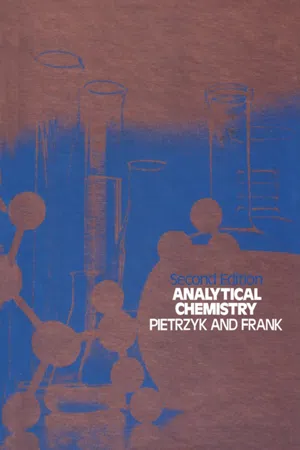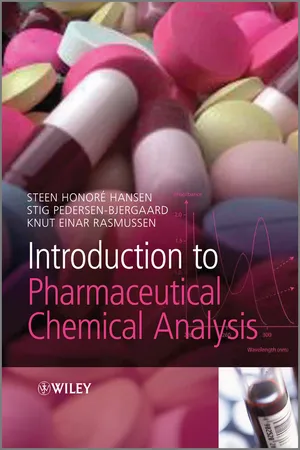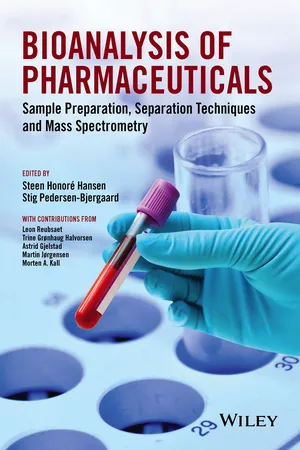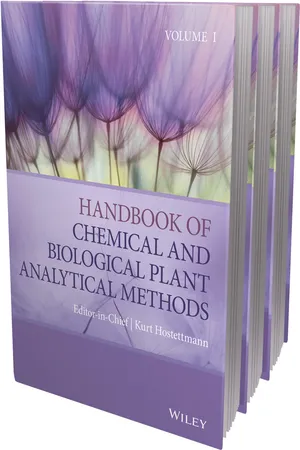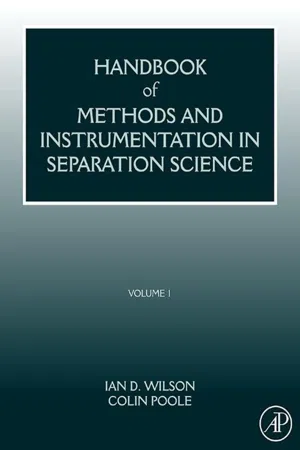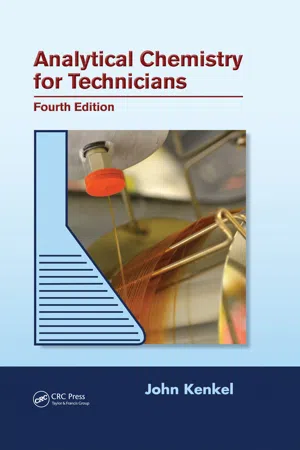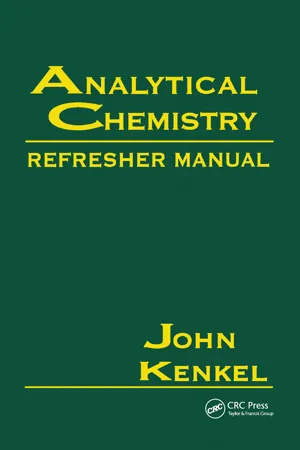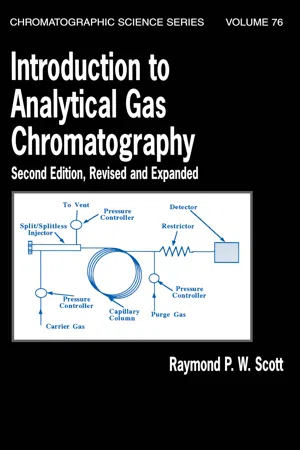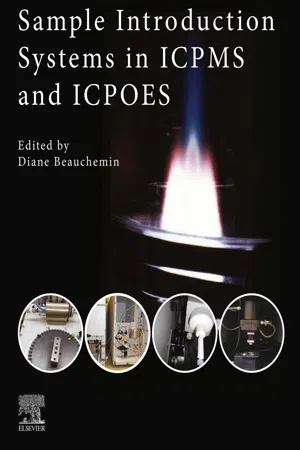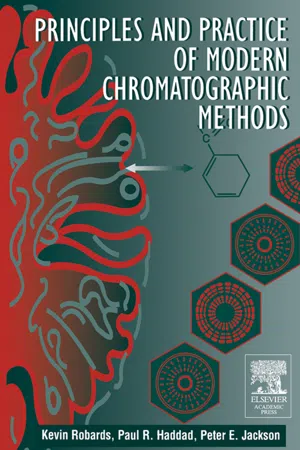Chemistry
Gas Chromatography
Gas chromatography is a technique used to separate and analyze volatile compounds in a mixture. It involves the passage of a gaseous sample through a column with a stationary phase, where different compounds interact at different rates and are separated based on their unique properties. The separated compounds are then detected and quantified, making gas chromatography a valuable tool in analytical chemistry.
Written by Perlego with AI-assistance
Related key terms
Related key terms
1 of 4
Related key terms
1 of 3
10 Key excerpts on "Gas Chromatography"
- eBook - ePub
- Clyde Frank(Author)
- 2012(Publication Date)
- Academic Press(Publisher)
Chapter Twenty-FourGas Chromatography
Publisher Summary
This chapter describes Gas Chromatography as a technique whereby the components of a mixture in the gaseous state are separated as the sample passes over a stationary liquid or solid phase. Differences in the interactions between the sample components and the stationary phase account for the separation. Gas Chromatography is fully developed and it is now applicable to almost every area within the physical and chemical sciences. The method has many advantages in that it can be used for qualitative and quantitative analyses, the time of analysis is short, the instrument is simple, the sensitivity is high, and the method is applicable to about 60% of the organic compounds known to man. The separations technique is very simple and straightforward with Gas Chromatography. The successful separation of cis and trans isomers, of oxygen isotopes, or of pesticides is a matter of choosing the proper column and conditions. The chapter also discusses chromatogram, instrument, and factors affecting separation.INTRODUCTION
Gas Chromatography is a technique whereby the components of a mixture in the gaseous state are separated as the sample passes over a stationary liquid or solid phase. Differences in the interactions between the sample components and the stationary phase account for the separation. Although gas phase separations through adsorption were reported in the early 1900s, it was not until 1952 that the true significance and potential of Gas Chromatography was realized. Since that time, Gas Chromatography has been developed to the point where it is now applicable to almost every area within the physical and chemical sciences. The method has many advantages in that it can be used for qualitative and quantitative analyses, the time of analysis is short, the instrument is simple, the sensitivity is high, and the method is applicable to about 60% of the organic compounds known to man. - eBook - ePub
- Steen Honoré Hansen, Stig Pedersen-Bjergaard, Knut Rasmussen(Authors)
- 2011(Publication Date)
- Wiley(Publisher)
Chapter 14 Gas Chromatography14.1 IntroductionGas Chromatography is a separation technique used for the analysis of volatile substances or substances that can be made volatile. Analytes are separated as a function of different distribution ratios between the mobile and the stationary phase. The mobile phase is a gas under pressure flowing through the heated column containing the stationary phase. In Gas Chromatography the mobile phase is called the carrier gas. The stationary phase is placed on the inner surface of the column or coated onto particles packed into the column. The column is a long tube made of fused silica or metal. The sample is injected into a heated injector at the beginning of the column where the constituents evaporate. The carrier gas carries the analytes through the column where the substances are distributed between the stationary phase and the mobile phase. Analytes with different distribution ratios between the phases are carried through the column at different speeds towards the detector. The separated substances are detected by a detector placed at the end of the column. Gas Chromatography is suitable for the separation of substances which are volatile and thermally stable or can be converted into volatile and thermally stable derivatives.In GC the mobile phase is an indifferent gas that does not react with the analytes. Analytes must be volatile in order to be transported by the carrier gas to the detector. Consequently, only volatile substances can be separated by GC. The volatility of the substances is temperature-dependent, the higher the temperature the higher the vapor pressure of the substances. Substances that are readily volatile and evaporate easily can be analyzed at a lower temperature than less volatile substances. The temperature can be too high, because the substances may decompose at high temperatures. The applicability of GC as to which substances that can be analyzed is therefore dependent on the volatility and thermal stability of the substances in question. Large polar molecules such as peptides, proteins, nucleotides, polysaccharides and other biomolecules cannot be separated by GC. - eBook - ePub
Bioanalysis of Pharmaceuticals
Sample Preparation, Separation Techniques and Mass Spectrometry
- Steen Honoré Hansen, Stig Pedersen-Bjergaard, Steen Honoré Hansen, Stig Pedersen-Bjergaard(Authors)
- 2015(Publication Date)
- Wiley(Publisher)
Chapter 8 Gas Chromatography (GC)Stig Pedersen-BjergaardSchool of Pharmacy, University of Oslo, NorwaySchool of Pharmaceutical Sciences, University of Copenhagen, DenmarkGas Chromatography (GC) is a technique used for separation and detection of volatile substances or substances that can be converted into volatile derivatives. In GC, a microliter volume of sample is injected into a heated injection port, where the sample constituents immediately are evaporated. The sample vapor is then transferred with the carrier gas from the injection port and into the separation column (GC column). The inner wall of the GC column is coated with a thin layer of stationary phase. The different sample constituents are transported with the carrier gas through the GC column. However, their velocities are different, depending on their volatility and their degree of interaction with the stationary phase. Compounds with low volatility and strong interaction with the stationary phase will be strongly retained in the GC column, and move slowly along the column. Thus, different sample constituents are physically separated based on different volatility and different affinity toward the stationary phase. At the end of the GC column, a detector is located to detect and measure the individual sample constituents.8.1 Basic Principles of GC
The basic principle of GC is illustrated in Figure 8.1 . A microliter volume of sample is injected by a small syringe into the injection port on top of the GC. The injection port is heated, and the sample constituents immediately evaporate inside the injection port.Schematic illustration of a gas chromatographFigure 8.1The evaporated sample constituents are then transported along the capillary column with the carrier gas. The carrier gas is the mobile phase in GC. The capillary column (=GC column - Shilin Chen, Andrew Marston, Hermann Stuppner, Shilin Chen, Andrew Marston, Hermann Stuppner(Authors)
- 2014(Publication Date)
- Wiley(Publisher)
et al., 2010b), and the ever-more-important role played by data processing to meet increasing demands for a “higher” level of information, among others, have radically changed analysis strategies over the past 15–20 years. In developing a modern method for analyzing the plant volatile fraction, a sequence of complementary but closely connected successive steps must be kept in mind, that is, component separation, identification, quantitation (when required), and further data processing.The following sections of this chapter examine the most recent advances for routine work in GC and fast-GC combined with FID and MS, automatic component identification, quantitation approaches, enantioselective-GC combined with FID (ES-GC) and/or MS (ES-GC–MS), and multi dimensional GC (GC–GC and GC × GC) applied to the plant volatile fraction analysis.Chromatography in general comprises a process that separates the components (solutes) of a mixture, on the basis of a series of consecutive equilibria resulting from their differential interaction between two phases, the first fixed or stationary and having a large specific surface and the second (a liquid or a gas) moving in contact with or through the stationary phase.In GC, the mobile phase is a gas; if the stationary phase is a high viscosity, low volatility liquid and the separation is based on partition, it is defined as “gas-liquid chromatography” (GLC), whereas if the stationary phase is a solid and mainly operates in adsorption, it is known as “gas–solid chromatography” (GSC ) (Jennings, Mittlefehldt, and Stremple, 1997). The former is more widely used, whereas the latter is mainly adopted to separate highly volatile compounds, including fixed gases.The history of GC was concisely but effectively described by Bartle and Myers (2002). James and Martin (1952) are considered to be the inventors of GC; their 1952 study reported the separation of volatile fatty acids by partition chromatography with nitrogen as mobile phase and silicone oil/stearic acid supported on diatomaceous earth as stationary phase. However, the origins of GC lie in a 1941 publication in which Martin and Synge (1941) first described liquid-phase partition chromatography; in their words, “Very refined separations of volatile substances should be possible in a column in which permanent gas is made to flow over gel impregnated with a non-volatile solvent- eBook - ePub
- (Author)
- 2009(Publication Date)
- Academic Press(Publisher)
Gas Chromatography: Theory of Gas Chromatography
P.A. Sewell Ormskirk, Lancs, UKIntroduction
Gas Chromatography (GC) involves the separation of the components of a mixture by virtue of differences in the equilibrium distribution of the components between two phases; the gaseous (mobile) phase moves in a definite direction, while the other phase is stationary (stationary phase).Stationary Phase
In gas–liquid chromatography (GLC) the stationary phase is a liquid coated onto a solid support, which may or may not contribute to the separation process, or onto the walls of an open tube. The liquid may also be chemically bonded to the solid or capillary tube (bonded phase) or immobilized on it, e.g. by in situ polymerization (cross-linking) after coating (immobilized phase). In gas–solid chromatography (GSC) the stationary phase is an active solid (e.g. silica, alumina or a polymer). Gas Chromatography is always carried out within a tube and the combination of stationary phase and tube is referred to as the column (column chromatography). The stationary phase (liquid + support) may fill the whole inside volume of the tube (packed column) or be concentrated along the inside wall of the tube, leaving an unrestricted path for the mobile phase in the middle of the tube (open-tubular or capillary column).In open-tubular columns, the liquid stationary phase can be coated onto the essentially unmodified smooth inner wall of the tube (wall-coated open-tubular (WCOT) column). The inner wall may be made porous by etching the surface by chemical means or by depositing porous particles on the wall from a suspension, the porous layer acting as the stationary phase or as a support for a liquid (porous-layer open-tubular (PLOT) column); or the porous layer may consist of support particles deposited from suspension (support-coated open-tubular (SCOT) column). The term capillary column denotes a column (packed or open-tubular) having a small diameter. - eBook - ePub
- John Kenkel(Author)
- 2013(Publication Date)
- CRC Press(Publisher)
11 Gas Chromatography11.1 Overview
Gas Chromatography (GC) is an instrumental chromatography configuration, meaning we have electronic detection and peaks on a computer screen as discussed in Chapter 10 . The mobile phase is a gas and that is the reason it is called “Gas Chromatography.” The mobile phase is typically helium. Thus, a compressed gas cylinder of helium stands next to the bench, and this gas is plumbed into the interior of the instrument to connect with the column. The regulated pressure from the compressed gas cylinder is the force that pushes the helium through the column. The flow rate of the helium is controlled electronically by computer software or by a needle valve.The mixture to be separated is usually a mixture of organic liquids, although gases and inorganic substances may also be separated. A liquid mixture is “injected” into the instrument with use of a microliter syringe that has a sharp tip for piercing a septum. The mixture must be in the gas phase when “carried” by the helium through the column. This means that the liquids must be rapidly evaporated immediately upon injection. Such a rapid evaporation requires that the injection port be heated. The column and detector must also be heated in order to sustain them in the gas phase. For this reason, the column is placed in an oven. Thus, the mixture to be separated is injected with a syringe into a heated port fitted with a rubber septum. The flowing helium carries the evaporated mixture onto the column where the separation then takes place.The modern GC column has some unique features. Most often, it is a “capillary” column, meaning that it has a very small diameter, on the order of 0.1 to 0.25 mm. Also, the stationary phase liquid is not adsorbed on the surface of small particles packed inside, as was discussed generally for column configurations in Chapter 10 - eBook - ePub
- John Kenkel(Author)
- 2020(Publication Date)
- CRC Press(Publisher)
C HAPTER 9 G AS C HROMATOGRAPHY 9.1 INTRODUCTION One instrumental chromatography configuration mentioned in the preceding chapter is one in which the mobile phase is gaseous and the stationary phase is either liquid or solid. This configuration is called Gas Chromatography and is abbreviated simply GC. It may also be abbreviated either GLC or GSC in order to stipulate whether the stationary phase is a liquid (GLC) or a solid (GSC). Most Gas Chromatography procedures utilize a liquid stationary phase (GLC), and thus the chromatography “type” (see Chapter 8 for the distinction between “type” and “configuration”) is partition chromatography most of the time. For the novice having just read Chapter 8, it may be difficult to visualize a chromatography procedure that utilizes a gas for a mobile phase. The gas, often called the “carrier gas,” is typically purified helium or nitrogen. It flows from a compressed gas cylinder container via the regulated pressure of the cylinder and flow controller through a “column” containing the stationary phase where the separation takes place. There are two types of columns; two methods of holding the stationary phase in place. These will be discussed in Section 9.4. The fact that the mobile phase is a gas creates additional unique features, one of which has to do with the mechanism of the separation. When we discussed partition chromatography in Chapter 8, we were, for the most part, assuming a liquid mobile phase. The partitioning mechanism in that case involved only the relative solubilities of the mixture components in the two phases. With GLC, however, the mechanism, while still involving the solubilities of the mixture components in one phase, the liquid stationary phase, also involves the relative vapor pressures of the components, since we must have partitioning between one phase that is a liquid and another phase that is a gas - Raymond P.W. Scott(Author)
- 2017(Publication Date)
- CRC Press(Publisher)
Chapter 1Introduction to Gas ChromatographyChromatography has an interesting history and the technique is unique in many ways. In one of its several forms, it is the most commonly used procedure in contemporary chemical analysis. The gas chromatograph was the first configuration of chromatography equipment to be produced in a simple composite unit. It was also one of the first analytical instruments to be associated with a computer which controlled the analysis, processed the data and reported the results. Subsequent to the disclosure of the first gas chromatograph, Gas Chromatography developed at a phenomenal rate, growing from a simple research novelty to a highly sophisticated instrument, having a multi-million dollar market, in only 4 years. Nevertheless, the basic principles involved in chromatographic separations had been known for over 50 years, long before the evolution of Gas Chromatography took place.History of Chromatography
The first scientist to recognize chromatography as an efficient method of separation was the Russian botanist Tswett, who employed a primitive form of liquid solid chromatography to separate and isolate various plant pigments. The colored bands he produced on the adsorbent bed evoked the term chromatography for this type of separation. Although color has little to do with modern chromatography, the name has persisted and, despite its irrelevance, is still used as a term to describe all separation techniques that employ a mobile and a stationary phase. Chromatography was actually discovered by Tswett in the late 1890s but it was not until 1910 that he published a book (1) describing his chromatographic methods for the separation of some chromophylls. Unfortunately, the work of Tswett was not exploited to any significant extent, partly due to the original book being published in Russian, and partly due to the condemnation of the method by Willstatter and Stoll (2) in 1913. These scientists repeated Tswett’s experiments without heeding his warning not to use too aggressive adsorbents as these would cause the chlorophylls to decompose. The experiments of Willstatter et al.- eBook - ePub
- Diane Beauchemin(Author)
- 2020(Publication Date)
- Elsevier(Publisher)
Gas Chromatography (GC) is then an obvious choice of analysis if speciation of amenable compounds is desired. Another important feature of Gas Chromatography is its ability to do the “heavy lifting” when determining trace components in a high purity matrix. For example, a polar column such as a Carbowax 20M separates thiophene (C 4 H 4 S) as a contaminant in high purity benzene (C 6 H 6) for easier and more accurate measurement by ICPMS with a collision/reaction cell (CRC) where S + is converted into SO + to move the analyte signal away from an important O 2 + background (see Fig. 5.1). Fig. 5.1 Trace analysis of a 1 μL sample of 100 μg/kg thiophene (C 4 H 4 S) in a benzene (C 6 H 6) balance on a Carbowax 20M column split 20:1 (m / z stands for mass-to-charge ratio). 5.1.1 Gas Chromatography vs. liquid chromatography High performance liquid chromatography (HPLC) is well suited to ICPOES or ICPMS interfacing because the flow rates of the HPLC system and nebulization rates in the ICP are comparable (see Chapter 4). In many cases HPLC as an introduction system negates the need for derivatization. However, there can be problems associated with HPLC. Reverse phase HPLC with organic solvents can cause carbon deposition on the torch and cones reducing performance, and buffer solutions for ion chromatography (IC) can plug the nebulizer and suppress the signal. Gas Chromatography exhibits substantially better separation and resolution than HPLC for volatile and semivolatile species. High boiling point and highly polar compounds can be made more amenable to Gas Chromatography with proper derivatization. In addition to resolving power, introduction of the sample to the plasma is complete if all analytes from the column are 100% recovered. HPLC-ICPMS is arguably cheaper and faster for some applications while GC-ICPMS provides better sensitivity and more separation [ 1 ]. Popp et al - Kevin Robards, P. E. Jackson, Paul A. Haddad(Authors)
- 2012(Publication Date)
- Academic Press(Publisher)
J. Chromatogr . 1992;624:353.Grob, R.L., Kaiser, M. Environmental Problem Solving Using Gas and Liquid Chromatography, Journal of Chromatography Library Series, No. 21. Amsterdam: Elsevier, 1982. Guiochon, G., Guillemin, C.L. Quantitative Gas Chromatography for Laboratory Analyses and On-line Process Control, Journal of Chromatography Library Series, No. 42. Amsterdam: Elsevier, 1988. Haken, J.K. Gas Chromatography of Coating Materials. New York: Marcel Dekker, 1974.Holcomb, M., Wilson, D.M., Trucksess, M.W., Thompson, H.C. Determination of aflatoxins in food products by chromatography. J. Chromatogr . 1992;624:341.Jack, D.B. Drug Analysis by Gas Chromatography. Orlando: Academic Press, 1984. Krull I.S., ed. Trace Metal Analysis and Speciation, Journal of Chromatography Library Series, No. 47. Amsterdam: Elsevier, 1992. Middleditch, B.S. Analytical Artifacts GC, MS, HPLC, TLC and PC, Journal of Chromatography Library Series, No. 44. Amsterdam: Elsevier, 1992.Mosandl, A. Capillary Gas Chromatography in quality assessment of flavors and fragrances. J. Chromatogr . 1992;624:267.Onuska, F.I., Karasek, F.W. Open Tubular Column Gas Chromatography in Environmental Sciences. New York: Plenum Press, 1984.Rizzolo, A., Polesello, S. Chromatographic determination of vitamins in foods. J. Chromatogr . 1992;624:103.Robards, K., Whitelaw, M. Chromatography of monosaccharides and disaccharides. J. Chromatogr . 1986;373:81.Robards, K., Towers, P. Chromatography as a reference technique for the determination of clinically important steroids. Biomed. Chromatogr . 1990;4:1.Robards, K., Patsalides, E., Dilli, S. Gas Chromatography of metal β-diketonates and their analogues. J.Chromatogr . 1987;411:1.Shantha, N.C., Napolitano, G.E. Gas Chromatography of fatty acids. J. Chromatogr . 1992;624:37.1
Index pages curate the most relevant extracts from our library of academic textbooks. They’ve been created using an in-house natural language model (NLM), each adding context and meaning to key research topics.
Explore more topic indexes
Explore more topic indexes
1 of 6
Explore more topic indexes
1 of 4
